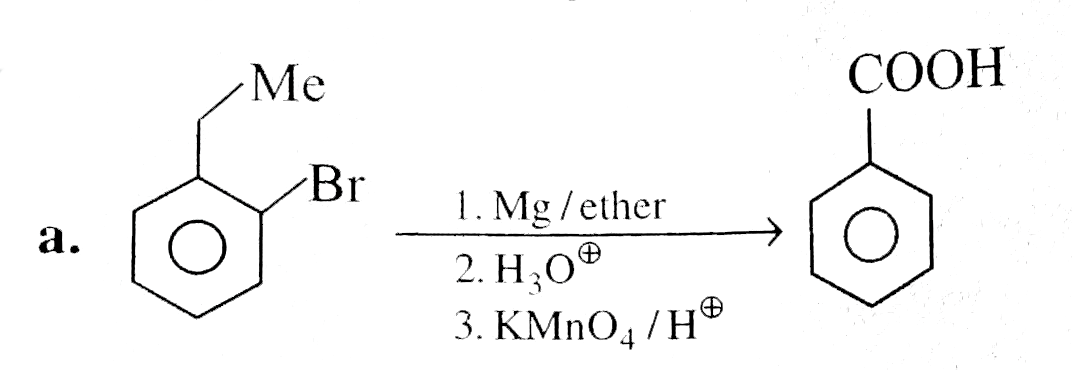Which of the following reaction(s) is/are wrong?
a.
b.
c.
d.
The correct Answer is:B, C
To determine which of the reactions are wrong, we will analyze each reaction step by step.
Step 1: Analyze Reaction A
1. Starting Material: A phenyl ring with an ethyl group (–CH2CH3) and a bromine atom (–Br) in the ortho position.
2. Reagent: Magnesium (Mg) in ether.
3. Reaction: The bromine reacts with magnesium to form a Grignard reagent (C6H5CH2CH3MgBr).
4. Outcome: The ethyl group remains intact, and the Grignard reagent is formed correctly.
Conclusion for Reaction A: This reaction is correct.
Step 2: Analyze Reaction B
1. Starting Material: The same phenyl ring with an ethyl group and bromine.
2. Reagent: Grignard reagent (from Reaction A) treated with CO2 followed by H3O+.
3. Reaction: The Grignard reagent reacts with CO2 to form benzoic acid (C6H5COOH) while the ethyl group remains unchanged.
4. Next Step: KMnO4 in the presence of H+ is used, which oxidizes the ethyl group to a carboxylic acid (–COOH).
5. Outcome: The final product should be phthalic acid (C6H4(COOH)2) after heating, which forms an anhydride.
Conclusion for Reaction B: The formation of an anhydride from phthalic acid is not correctly represented in the steps provided, making this reaction wrong.
Step 3: Analyze Reaction C
1. Starting Material: The same phenyl ring with an ethyl group.
2. Reagent: Chromyl chloride (CrO2Cl2) in CCl4.
3. Reaction: This is an ethyl reaction that should yield an aldehyde.
4. Outcome: The expected product should maintain the same number of carbons as the starting material. However, the reaction indicates a loss of one carbon atom.
Conclusion for Reaction C: The product has one less carbon than the reactant, indicating that this reaction is also wrong.
Step 4: Analyze Reaction D
1. Starting Material: The same phenyl ring with an ethyl group.
2. Reagent: KMnO4 in H+.
3. Reaction: This reaction oxidizes the side chain to benzoic acid.
4. Outcome: The product is correctly formed as benzoic acid.
Conclusion for Reaction D: This reaction is correct.
Final Conclusion
- Wrong Reactions: B and C
- Correct Reactions: A and D
Summary of Wrong Reactions:
- B: Incorrect due to the misrepresentation of anhydride formation.
- C: Incorrect due to loss of carbon in the product.
---
1. Starting Material: A phenyl ring with an ethyl group (–CH2CH3) and a bromine atom (–Br) in the ortho position.
2. Reagent: Magnesium (Mg) in ether.
3. Reaction: The bromine reacts with magnesium to form a Grignard reagent (C6H5CH2CH3MgBr).
4. Outcome: The ethyl group remains intact, and the Grignard reagent is formed correctly.
1. Starting Material: The same phenyl ring with an ethyl group and bromine.
2. Reagent: Grignard reagent (from Reaction A) treated with CO2 followed by H3O+.
3. Reaction: The Grignard reagent reacts with CO2 to form benzoic acid (C6H5COOH) while the ethyl group remains unchanged.
4. Next Step: KMnO4 in the presence of H+ is used, which oxidizes the ethyl group to a carboxylic acid (–COOH).
5. Outcome: The final product should be phthalic acid (C6H4(COOH)2) after heating, which forms an anhydride.
1. Starting Material: The same phenyl ring with an ethyl group.
2. Reagent: Chromyl chloride (CrO2Cl2) in CCl4.
3. Reaction: This is an ethyl reaction that should yield an aldehyde.
4. Outcome: The expected product should maintain the same number of carbons as the starting material. However, the reaction indicates a loss of one carbon atom.
1. Starting Material: The same phenyl ring with an ethyl group.
2. Reagent: KMnO4 in H+.
3. Reaction: This reaction oxidizes the side chain to benzoic acid.
4. Outcome: The product is correctly formed as benzoic acid.
- Wrong Reactions: B and C
- Correct Reactions: A and D
- B: Incorrect due to the misrepresentation of anhydride formation.
- C: Incorrect due to loss of carbon in the product.
Topper's Solved these Questions
- REDUCTION AND OXIDATION REACTION OF ORGANIC COMPOUNDSBOOK - CENGAGE CHEMISTRY ENGLISHCHAPTER - REDUCTION AND OXIDATION REACTION OF ORGANIC COMPOUNDSEXERCISE - Exercise (Single Correct)
90 Videos
- REDUCTION AND OXIDATION REACTION OF ORGANIC COMPOUNDSBOOK - CENGAGE CHEMISTRY ENGLISHCHAPTER - REDUCTION AND OXIDATION REACTION OF ORGANIC COMPOUNDSEXERCISE - Exercise (Assertion And Reasoning)
10 Videos
- REDUCTION AND OXIDATION REACTION OF ORGANIC COMPOUNDSBOOK - CENGAGE CHEMISTRY ENGLISHCHAPTER - REDUCTION AND OXIDATION REACTION OF ORGANIC COMPOUNDSEXERCISE - Exercise (Linked Comprehension)
52 Videos
- QUALITATIVE INORGANIC SALT ANALYSISBOOK - CENGAGE CHEMISTRY ENGLISHCHAPTER - QUALITATIVE INORGANIC SALT ANALYSISEXERCISE - Viva Voce Questions And Part-C (Analysis Of Cations)
42 Videos
- SOLID STATEBOOK - CENGAGE CHEMISTRY ENGLISHCHAPTER - SOLID STATEEXERCISE - Ex 1.2 (Objective)
9 Videos
Similar Questions
Which of the following reaction(s) is/are correct?
View SolutionWhich of the following statement(s) is/are wrong ?
View SolutionWhich of the following reaction are wrong?
View Solution
Which of the following statements is/are wrong ?
View SolutionWhich of the following statements is/are wrong?
View SolutionWhich of the following statements is/are wrong?
View SolutionWhich of the following statements is/are wrong?
View SolutionWhich of the following statements is/are wrong ?
View SolutionWhich of the following statements is/are wrong?
View SolutionWhich of the following statements is/are wrong?
View Solution
